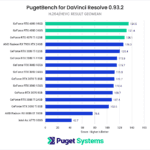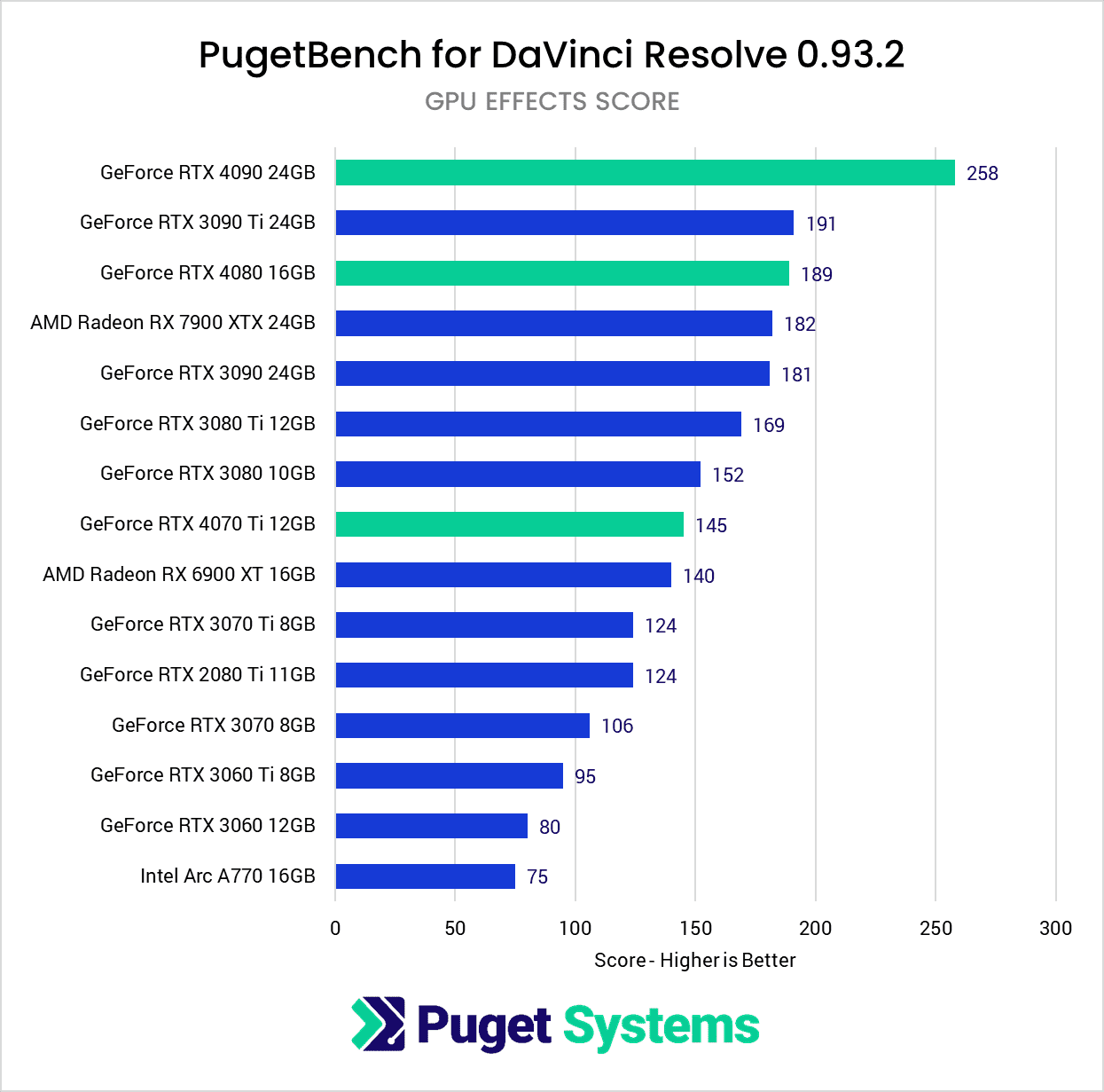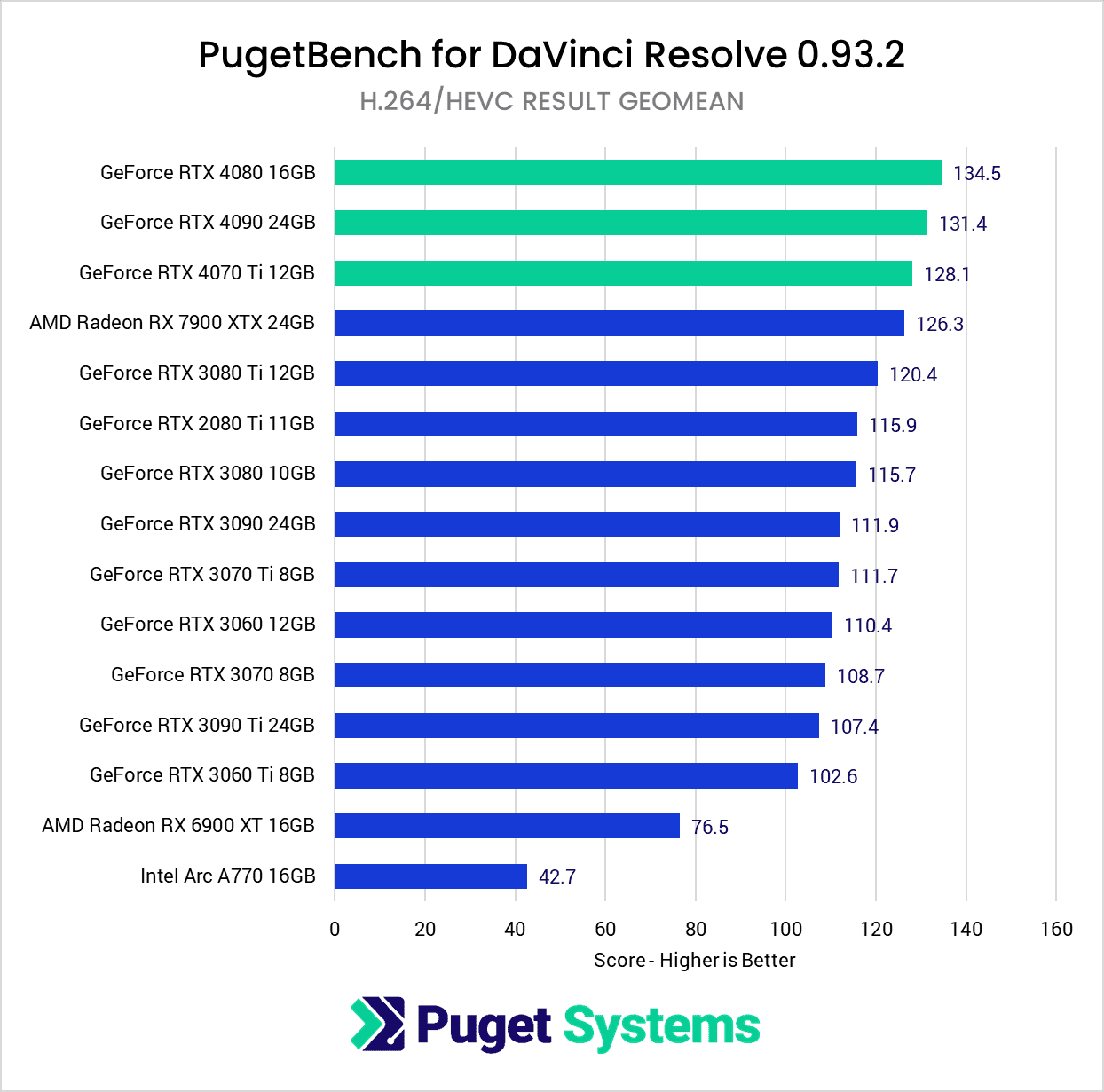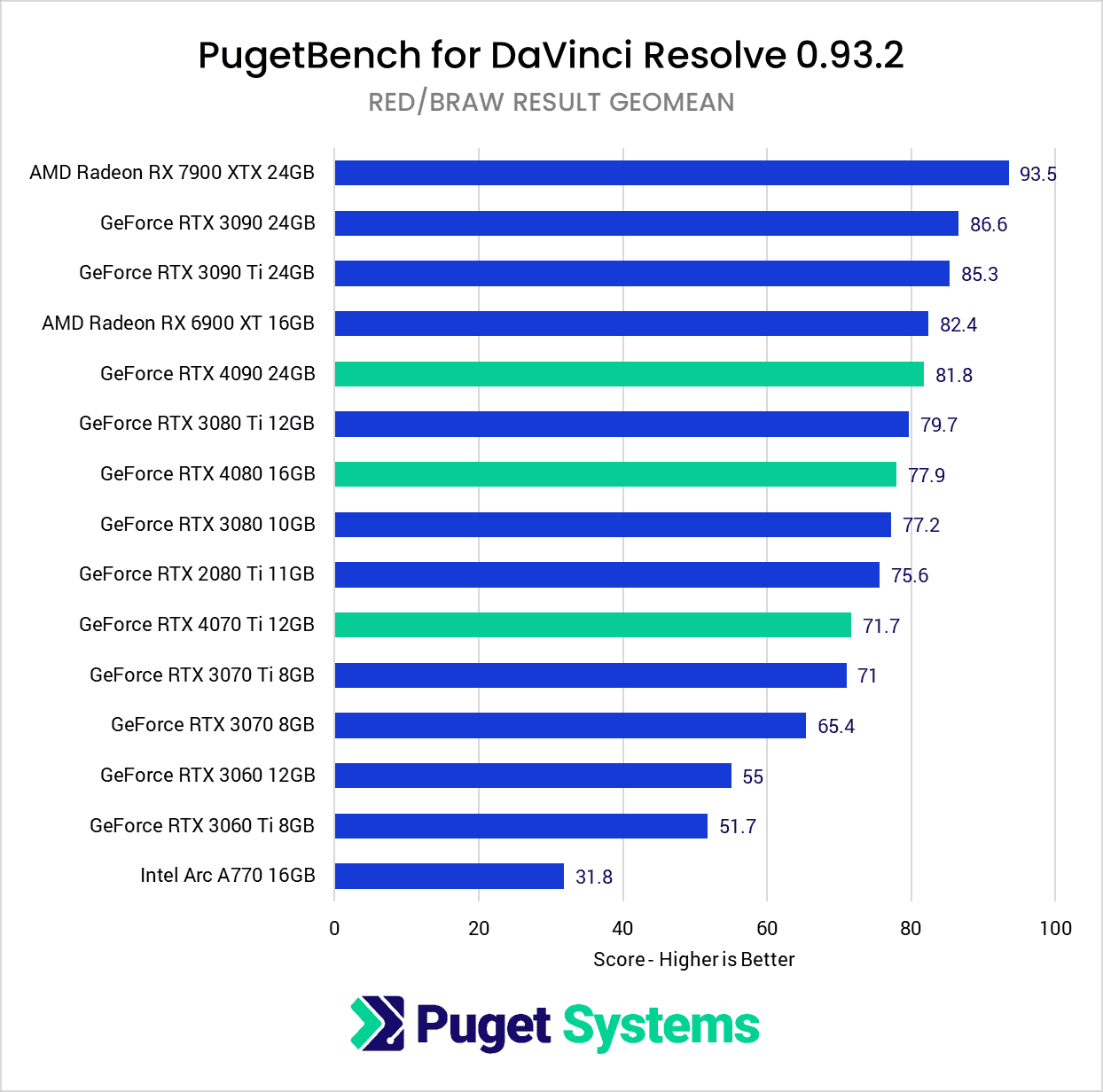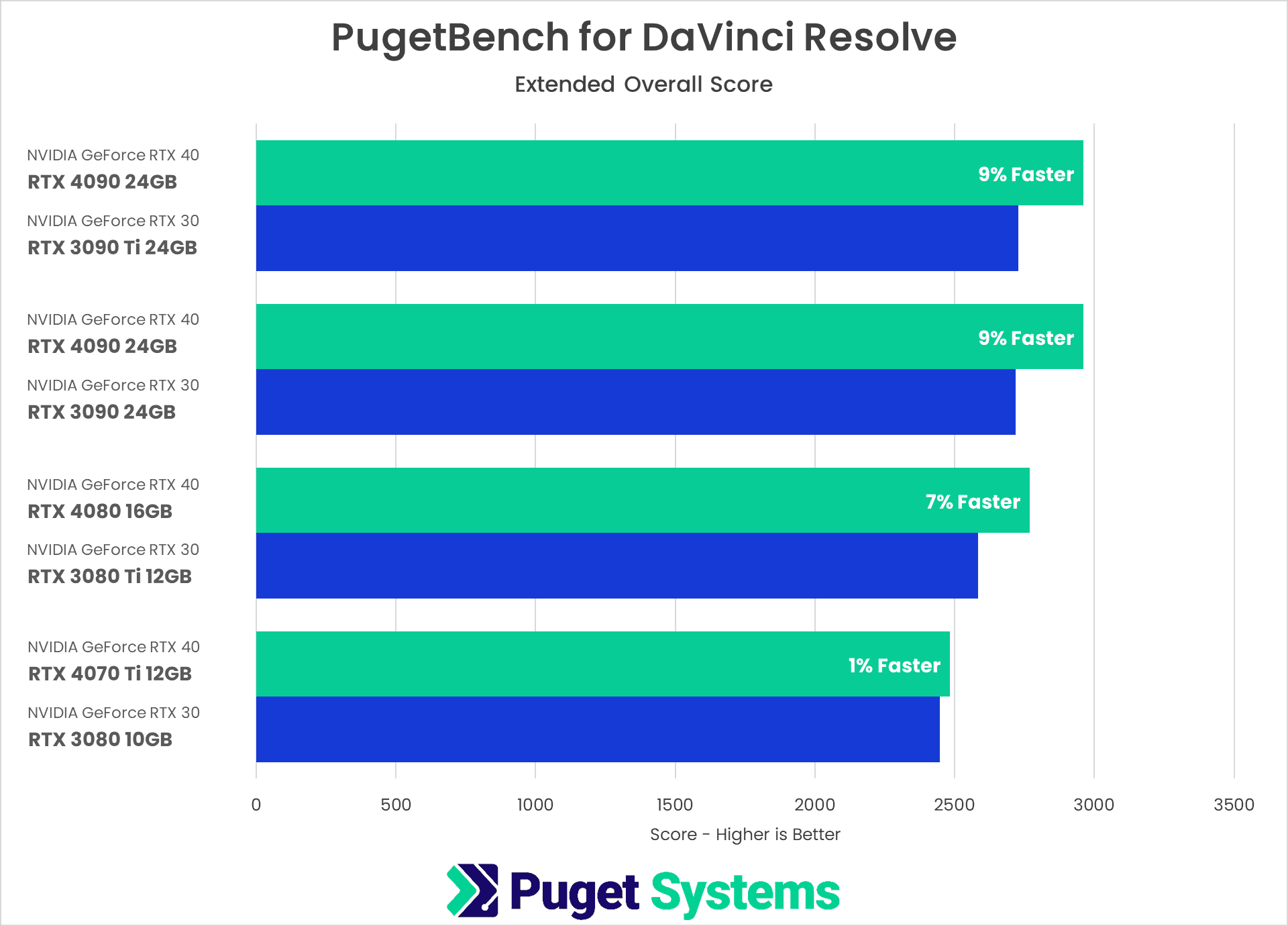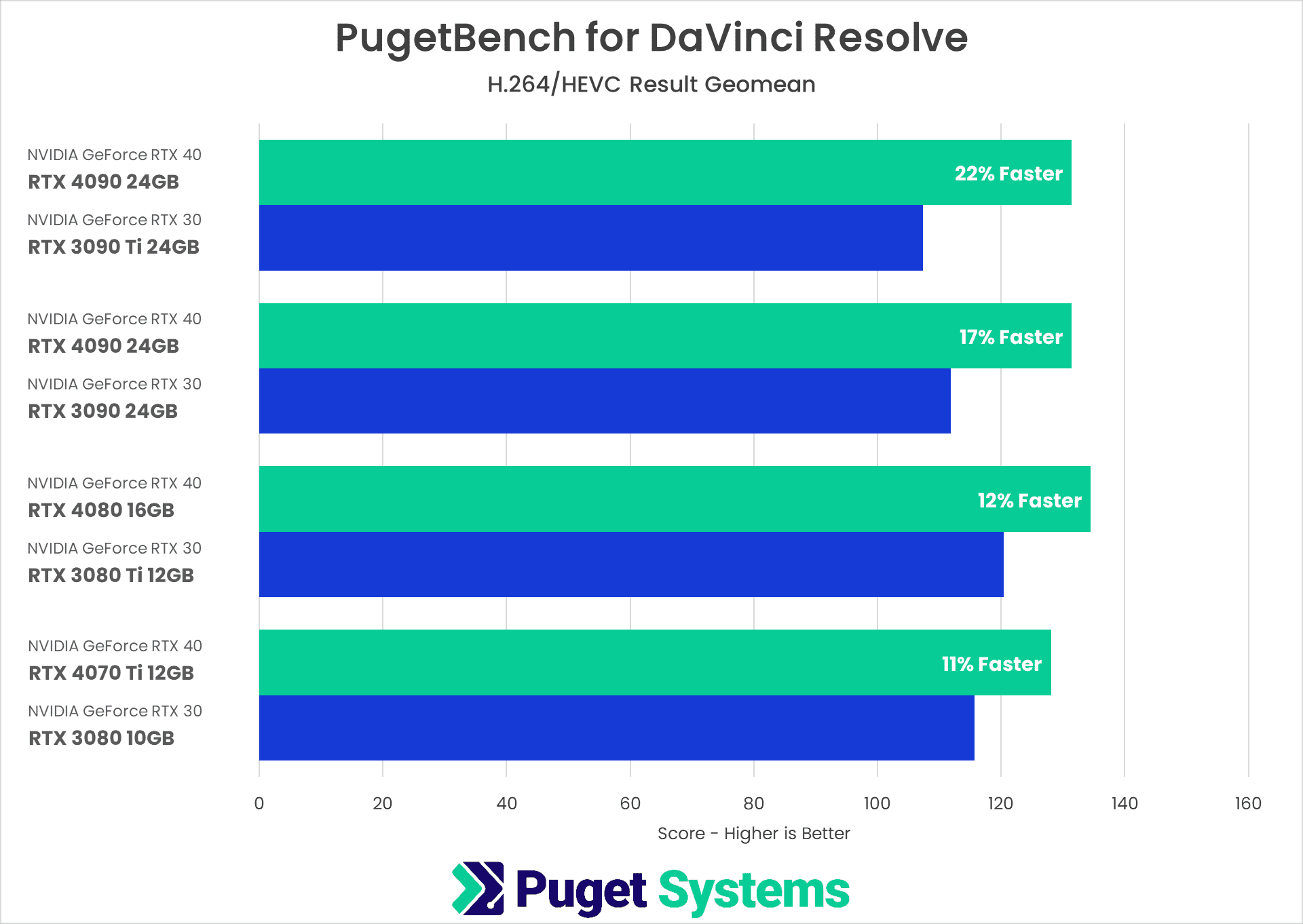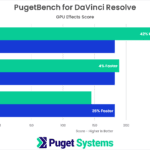Table of Contents
Introduction
NVIDIA has recently finalized their initial GeForce RTX 40 Series GPU lineup with the launch of the GeForce RTX 4070 Ti 12GB. Now that the RTX 4070 Ti has joined the RTX 4080 and 4090, we are excited to dive into in-depth testing of these cards’ performance in various content creation workflows.

In this article, we will be using our PugetBench for DaVinci Resolve benchmark paired with DaVinci Resolve Studio 18.1.2 to examine the performance of the GeForce RTX 40 Series for video editing, color grading, and motion graphics. As a comparison, we will be including the full lineup from the previous generation GeForce RTX 30 Series, the GeForce RTX 2080 Ti for additional context, as well as a sampling of cards from their primary competition – the AMD Radeon RX Series.
If you want to read more about the new GeForce RTX 40 Series cards (including the 4070 Ti, 4080, and 4090), and what sets them apart from the previous generation, we recommend checking out our main NVIDIA GeForce 40 Series vs AMD Radeon 7000 for Content Creation article. That post includes more detailed information on the GPU specifications, testing results for various other applications, and the complete test setup details for the hardware and software used in our testing.
Raw Benchmark Results
While we will be going through our testing in detail in the next section, we always like to provide the raw results for those that want to dig into the details. If there is a specific task you tend to perform in your workflow, examining the raw results will be much more applicable than our more general analysis.
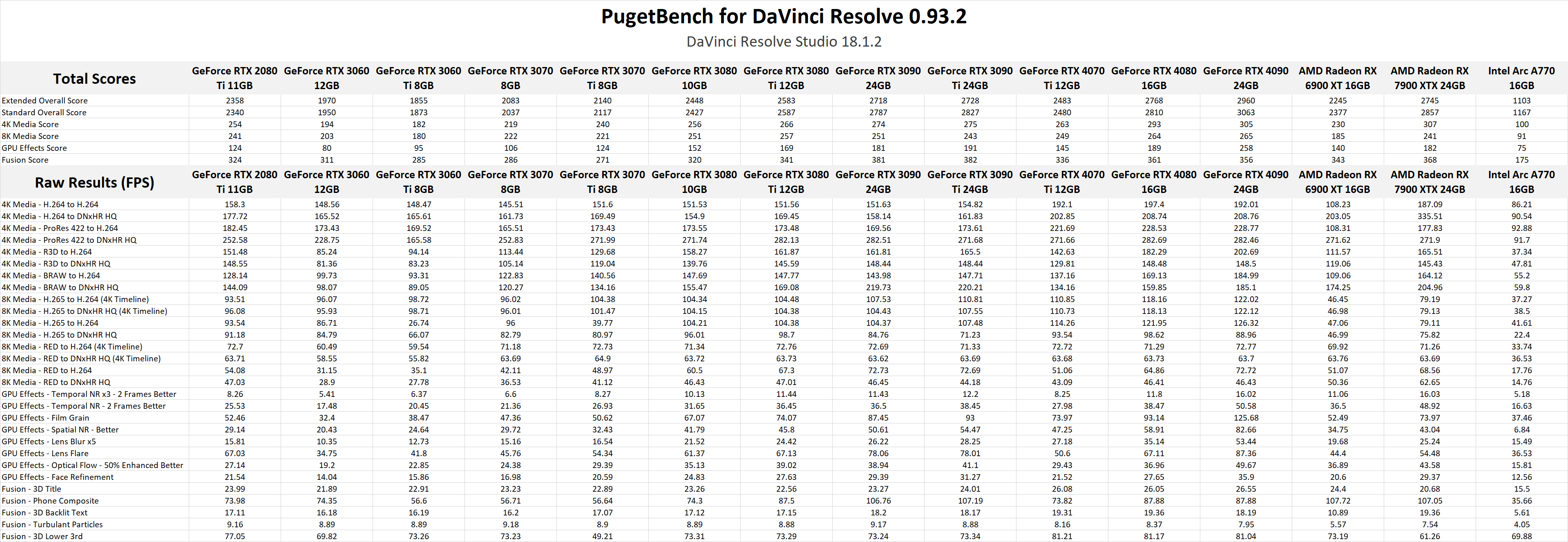
Overall DaVinci Resolve Studio Performance Analysis
When it comes to GPU performance in DaVinci Resolve Studio, there are four main areas we typically focus on:
- Overall Score across all tasks
- GPU-accelerated effects performance
- H.264/HEVC decoding/encoding performance
- RAW debayering performance
It is important to note that while many of these results apply to the free version of DaVinci Resolve, the Studio version unlocks many of the GPU effects and adds hardware decoding support for H.264/HEVC media. So, while these results are generally correct for both versions, they are intended primarily for those using the paid Studio version.
Out of the four categories listed above, the Overall Score is likely to be the most relevant single result for most users as it is a combination of various workflows in DaVinci Resolve. However, it includes several tasks that don’t utilize the GPU much. It likely lines up with how most use DaVinci Resolve day-to-day, but if you want to take a closer look at how different cards impact performance in more GPU-focused workloads, that is where the other scores come into play. We will note that the H.264/HEVC and RAW scores in charts #3 and #4 above are currently not a part of our public benchmark. This is something we plan on focusing more heavily on in upcoming versions of the benchmark, but for now, we are calculating those scores after the fact by using a geometric mean of the relevant tests.
You are free to examine the charts above if you want to see performance across all the GPUs we tested, but to simplify things we are going to break down the results based on the two main questions the majority of readers are likely to be interested in: How does the RTX 40 Series compare to the previous generation RTX 30 Series, and how they compare to their primary competition from AMD.
NVIDIA GeForce RTX 40 Series vs RTX 30 Series
We usually like to make comparisons based on the pricing of each GPU, but it is worth noting that GPU pricing is still extremely volatile. We will use the MSRP as a baseline in this post, but be aware that exact apples-to-apples comparisons may change according to current market pricing. But, in terms of MSRP, the closest comparisons between the new RTX 40 Series cards and the previous generation are:
- RTX 4090 24GB vs RTX 3090 24GB ($1,599 vs $1,499)
- RTX 4080 16GB vs RTX 3080 Ti 12GB ($1,199 vs $1,199)
- RTX 4070 Ti vs RTX 3080 10GB ($799 vs $699)
In addition, we also decided to throw in the RTX 4090 24GB versus the RTX 3090 Ti 24GB ($1,599 vs $1,999) as a “best of both generations” comparison.
Starting with the Overall Score, the RTX 40 Series doesn’t have that much to show for itself. The RTX 4090 is a decent 9% faster than the RTX 3090 and 3090 Ti, but the RTX 4080 is only 7% faster than the RTX 3080 Ti, and the RTX 4070 Ti is only on par with the RTX 3080.
As we mentioned earlier, however, the Overall Score includes many workloads that do not heavily utilize the GPU. Because of this, we also want to drill down into some specific workloads in DaVinci Resolve that better utilize a more powerful GPU. First up, in chart #2 we are looking at the performance for GPU-accelerated effects like noise reduction, optical flow, and blurs. For these tasks, the RTX 4090 is able to show off how fast it is, coming in at 43% faster than the RTX 3090 and 35% faster than the RTX 3090 Ti.
The RTX 4080 is less impressive, but still manages a double-digit gain over the previous generation. The oddball is the RTX 4070 Ti, which ended up being about 5% slower than the RTX 3080. We know from our other GPU-focused testing like OctaneBench and Blender that the RTX 4070 Ti should be faster than the RTX 3080 in terms of raw horsepower, but for whatever reason, DaVinci Resolve cannot take advantage of the performance of this card. It could be either a driver or software bug, but either way, it isn’t a great showing for the RTX 4070 Ti – especially since it is more expensive than the RTX 3080 in the first place.
Beyond GPU-accelerated effects, your GPU choice can also impact performance when working with specific codecs. Currently, the two most common codecs where the GPU comes into play are decoding/encoding for LongGOP codecs (H.264 and HEVC in our benchmark), and debayering of RAW media (RED and BRAW in our case).
H.264 and HEVC codecs are among the most commonly used codecs for video editing (even if they are also among the worst for editing performance), and DaVinci Resolve shows some very nice performance gains with the RTX 40 Series cards. The exact amount varies by model, but in chart #3, you can see that we measured anywhere from an 11% to 22% increase in performance over the previous generation. This will only come into play if you are working with specific types of H.264 and HEVC media that DaVinci Resolve has Hardware Decoding support for, but in those cases, the RTX 40 Series cards give an excellent performance bump.
On the other hand, RAW debayering (chart #4) isn’t as great of a result for the RTX 40 Series, with performance that is actually worse than the previous generation. After diving into the individual RAW results, it appears that this issue is primarily with BRAW media. RED RAW isn’t great either as the RTX 40 Series is almost identical to the RTX 30 Series, but BRAW is where the performance drop appears to be focused. Like the earlier RTX 4070 Ti result, this is likely due to a driver or software bug, but we’ll have to see if it improves over time.
NVIDIA GeForce RTX 40 Series vs AMD Radeon RX
Unlike NVIDIA, AMD has a fairly slim GPU product line. They don’t have anything approaching the MSRP of the GeForce RTX 4090, and only have two models currently available for their Radeon 7000 Series: the Radeon RX 7900 XT and the Radeon RX 7900 XTX. For the purposes of this article, we are only going to include the Radeon RX 7900 XTX. Just keep in mind that the 7900 XTX is $200 more expensive than the 4070 Ti, $200 less expensive than the RTX 4080, and far less expensive than the RTX 4090 (at least in terms of official MSRP). Because of this, we are never going to be looking for an exact match, but rather how NVIDIA and AMD compare on a relative level.
Starting with the Overall Score, AMD is the winner in terms of price-to-performance. The Radeon 7900 XTX is an excellent 11% faster than the RTX 4070 Ti and on par with the more expensive RTX 4080. It can’t catch up to the RTX 4090, but given the price difference between the two, NVIDIA’s 8% lead is not a large one.
Things are a bit more complicated when we break it down by workflow. In chart #2 we are looking at the performance of GPU-accelerated effects in DaVinci Resolve, which is one of the main areas where people are often bottlenecked by the GPU. Here, NVIDIA has a firm lead in terms of maximum performance, with the RTX 4090 coming in at a massive 42% faster than the Radeon 7900 XTX. It is $600 more expensive, but from an ROI standpoint, NVIDIA has a pretty strong position.
Things are quite a bit better for AMD when we get closer to the MSRP of the 7900 XTX. The RTX 4080 holds a slim lead, but the RTX 4070 Ti is about 25% slower than the 7900 XTX. We expect that gap to close somewhat when the 4070 Ti’s performance issues in Resolve get addressed (assuming it is a simple bug, of course), but AMD is at least as good as – or a better – performance option than NVIDIA at the sub-$1000 price range.
For codec performance, we will start with our H.264 and HEVC tests (chart #3). Here, NVIDIA has a slim lead, but the difference is so small that you likely wouldn’t be able to tell the difference between the RTX 40 Series and the AMD Radeon 7000 Series. If this type of codec is something you work with regularly, we would argue that more important than the GPU is to have an Intel Core CPU that supports Quick Sync (as that would be used for H.264/HEVC decoding in place of the GPU). Not only is performance typically a bit better, but it would give you hardware decoding support for a much wider range of HEVC flavors.
Last up is the performance of RED RAW media (chart #4). Since the RTX 40 Series are slower than the previous generation RTX 30 Series, NVIDIA falls further behind the Radeon 7900 XTX by anywhere from 15% to 30%. This is an odd result since NVIDIA was faster than AMD in our Premiere Pro testing. More and more, it appears that the RTX 40 Series simply have some issues with the current version of DaVinci Resolve. It could be an issue with Resolve itself or an issue with the latest GPU driver. But either way, this is not what we expect to see from the RTX 40 Series cards, and we hope that these issues are resolved soon.
How Well Do the NVIDIA GeForce RTX 40 Series Perform in DaVinci Resolve?
Right now, the NVIDIA GeForce RTX 40 Series is a bit of a mixed bag for DaVinci Resolve. There are several areas (such as GPU effects) where they excel, but other areas where it appears that there are some bugs that need to be worked out. Key among those are performance with RAW codecs like RED and BRAW, where the RTX 40 Series are either no faster, or measurably slower than the previous generation RTX 30 Series. Processing of RAW media is also an area where AMD Radeon 7000 Series GPUs are particularly strong, which means that because of the gen-over-gen performance degradation, AMD takes a commanding performance lead for those workflows.
We expect that the isolated issues with the RTX 40 Series in DaVinci Resolve are due to either a software or driver bug, and hope to see them fixed at some point in the near future. Until that happens, however, NVIDIA’s historical dominance for video editing applications like DaVinci Resolve is under serious threat. Many of the heavy-duty workflows that require massive amounts of GPU power are still firmly in NVIDIA’s grasp with the RTX 4090, but AMD has been making strides over the last few GPU generations and is at the point where they could be the better choice depending on your budget and workflow.
Now, this is only talking about pure performance. AMD has other advantages, such as providing much higher VRAM amounts than their NVIDIA counterparts. On the other hand, NVIDIA is often more stable from a drivers standpoint, and their Tensor cores can be very useful for many of the new AI-based features in DaVinci Resolve. And sometimes, it simply comes down to what GPU you can actually get your hands on.
Overall, we have a few reservations about recommending the RTX 40 Series GPUs, but for most DaVinci Resolve users, they should work great. The RTX 4070 Ti is a bit of an under-performer, but the big sticking point for them is if you work with RAW media. In that case, you may want to stick to the RTX 30 Series GPUs or consider going with the AMD Radeon 7900 XTX. If those RAW issues are resolved soon, however, it would be much easier to recommend the RTX 40 Series across the board.
If you are looking for a workstation for DaVinci Resolve Studio with an NVIDIA GeForce RTX 40 Series GPU, we recommend checking out our DaVinci Resolve solutions page or contacting one of our technology consultants for help configuring a workstation that meets the specific needs of your unique workflow.




